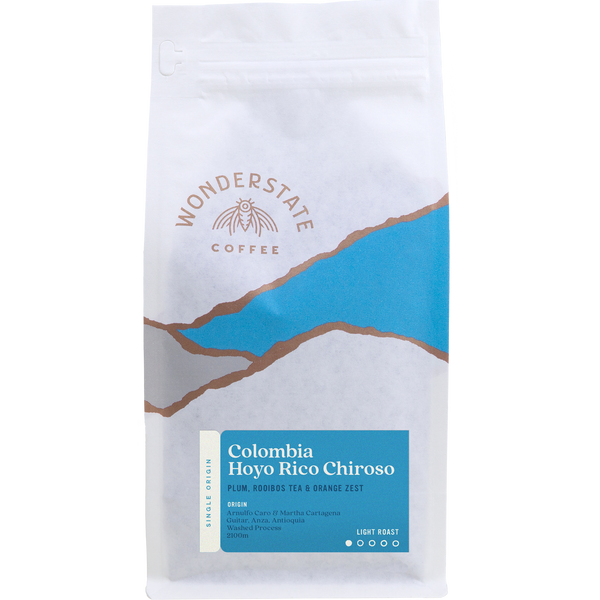Producer: Arnulfo Cara & Martha Cartagena
Altitude:
2100 meters
Varietals:
Chiroso
Process:
3-4 days fermentation in cherry, depulped and fermented for an additional 8 days, dried 2-3 weeks on raised beds
Harvest:
November - January 2025
Region:
Guitar, Anza, Antioquia
What We Love
Colombian coffee is in a constant state of evolution. The landscape of production, quality, varieties, and processing keeps us on our toes, and our ears close to the ground. Among the most exciting newcomers is the Chiroso variety, already making waves across Colombia. This lot from Arnulfo Caro marks our first time working with Chiroso, and we couldn’t be more delighted.
In the cup, Hoyo Rico Chiroso carries a resonant sweetness and silky texture, with notes of autumn plum and orange zest. The finish is endlessly complex, drifting between the gentle warmth of rooibos tea and the herbal lift of oregano oils. Each brew reveals new layers, making this coffee as captivating to the imagination as it is to the palate.
About the Farmer
This selection comes from Hoyo Rico, the farm of Arnulfo Caro and Martha Cartagena. Like many in the region, Arnulfo once worked as a miner. Inspired by the success of his brother, Santiago Caro, in specialty coffee, Arnulfo made the leap from mining to cultivation. Santiago shared Chiroso seedstock with him, opening doors to markets that had previously been out of reach.
Though modest in size at just under five acres, Arnulfo and Martha farm with vision and ambition. They are part of a broader community of growers in Urrao who have embraced specialty coffee as a path forward, a movement supported by Unblended Coffee, their exporting partner.
Unblended has spent years working closely with the Caro family and their neighbors, providing transparent pricing and connecting farmers with roasters. What makes Unblended distinct is their dual commitment: not only linking producers to markets, but also fostering mentorship networks within communities. Farmers share knowledge with one another on processing and harvesting, building a collective capacity for quality and resilience. In that sense, their work mirrors our own values at Wonderstate: transparent, relationship-driven, and always oriented toward creating lasting opportunities for farmers.
In September, we joined Unblended in Urrao and witnessed firsthand the breathtaking landscape: rolling green hills cut by fast-flowing rivers, pastoral and peaceful. That setting, paired with the vision of farmers like Arnulfo and Martha, makes us grateful to bring these coffees into our lineup.
About the Coffee
For decades, Urrao was overlooked in Colombia’s coffee story. Tucked away in the southwest of Antioquia, its valleys were considered too cold, too remote, too marginal for anything beyond cattle, dairy, and subsistence crops. Coffee from Urrao rarely traveled far, and the town remained an outpost: a place written out of the maps that traced prestige through Huila, Nariño, and better-known Antioqueño towns.
Then came Chiroso. With a flavor spectrum reminiscent of Ethiopia, Chiroso turned the narrative on its head. Almost overnight, the forgotten valleys of Urrao became the new frontier, producing coffees that stunned the world. What had been ordinary revealed itself as extraordinary. For farmers, this shift wasn’t just economic, it was cultural: proof that their land and traditions could command global attention. Urrao became a reminder that Colombia’s coffee story is never finished. It is always being rewritten.
Chiroso’s origins remain a mystery, though genetic research has confirmed it is an Ethiopian landrace. Like Gesha, Sidra, and Pink Bourbon, its potential for cup quality is extraordinary. This expression of Chiroso carries the hallmark sweetness, subtle florality, and silky texture of Ethiopia’s “heirloom” coffees, while also speaking clearly of the terroir of Urrao and Anzá. The result is a cup profile far beyond what most expect from standard Colombian coffees.
This lot underwent a mixed-fermentation process: cherries rested for 3–4 days post-harvest before an 8-day wet fermentation. After washing, the coffee was dried slowly on raised beds for 2–3 weeks. Instead of producing ferment-driven or winey notes, this extended process yielded a transparent, elegant profile that highlights the distinct landscape of Anza.
You might also like
